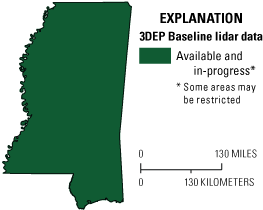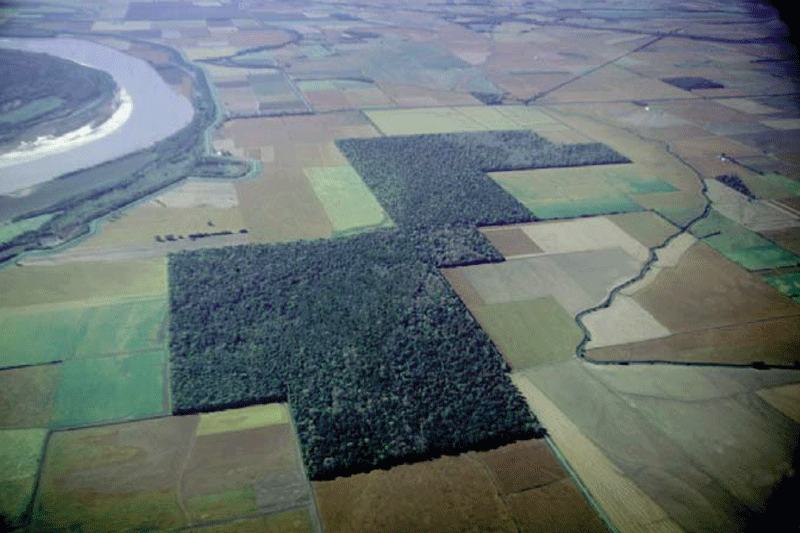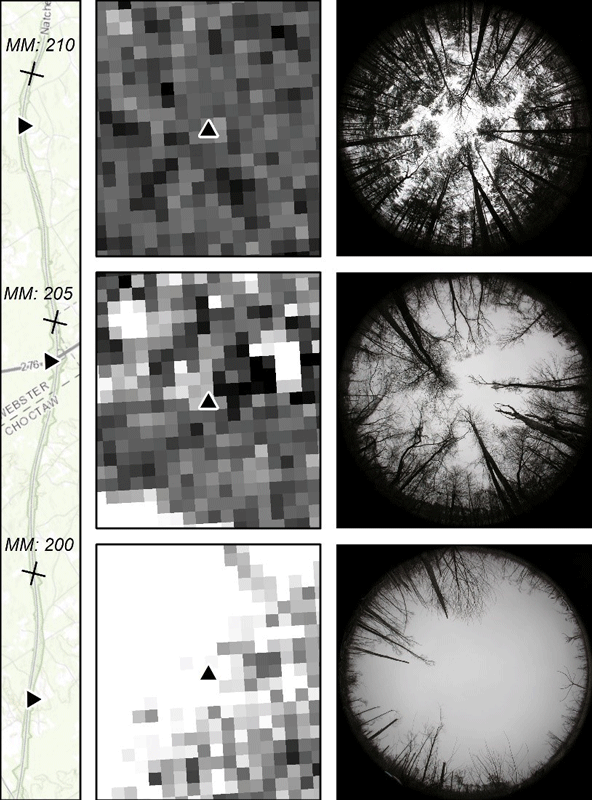The 3D Elevation Program—Supporting Mississippi’s Economy
Links
- Document: Report (500 KB pdf) , HTML , XML
- Download citation as: RIS | Dublin Core
Introduction
Mississippi has a dispersed population of nearly three million residents in an area of approximately 48,400 square miles and has a favorable climate for agriculture, with abundant precipitation and minimal extreme temperatures. The topography consists mostly of low hills and lowland plains, with the highest elevation about 800 feet above sea level. An exception is the nearly flat Mississippi Alluvial Plain, or “Delta,” in the northwestern part of the State. Agriculture and forestry are Mississippi’s major industries. With 65 percent of its area forested, the State is one of the country’s top producers of lumber and wood-related products. In addition to agriculture and forest resources management, other important economic activities are infrastructure and construction management, flood risk management, and water supply and quality assessment. High-quality elevation data can help to support these activities. Critical applications that meet the State’s management needs depend on light detection and ranging (lidar) data that provide a highly detailed three-dimensional (3D) model of the Earth’s surface and aboveground features.
The 3D Elevation Program (3DEP; refer to sidebar) is managed by the U.S. Geological Survey (USGS) in partnership with Federal, State, Tribal, U.S. territorial, and local agencies to acquire consistent lidar coverage at quality level 2 or better (table 1) to meet the many needs of the Nation and Mississippi. The status of available and in-progress 3DEP baseline lidar data in Mississippi is shown in figure 1. 3DEP baseline lidar data include quality level 2 or better, 1-meter or better digital elevation models, and lidar point clouds, and must meet the Lidar Base Specification version 1.2 (https://www.usgs.gov/3dep/lidarspec) or newer requirements. The National Enhanced Elevation Assessment (Dewberry, 2012) identified user requirements and conservatively estimated that availability of lidar data would result in at least $10.4 million in new benefits annually to the State. The top 10 Mississippi business uses for 3D elevation data, which are based on the estimated annual conservative benefits of 3DEP, are shown in table 2.
Table 1.
Data quality levels, pulse spacing, and pulse density. Quality level 2 or better lidar data meet 3DEP requirements.[Specifications for quality level 0 (QL0) are from Heidemann (2012, p. 3 and table 1); for quality levels 1 and 2, specifications are from Sugarbaker and others (2014, table 1). In the quality level column, QL0 represents the highest level of quality. RMSEz, root mean square error in the elevation (z) dimension; cm, centimeter; m, meter; pls/m2, first return pulses per square meter; ≤, less than or equal to; ≥, greater than or equal to]

Map of Mississippi showing status of 3D Elevation Program (3DEP) baseline lidar data as of March 2024. Visit https://usgs.gov/NationalMap/LidarExplorer to find and download currently available data.
Water Supply and Quality
The Mississippi Alluvial Plain is subject to significant flooding, which can cause substantial change to surface flow patterns, and activities in it rely heavily on a groundwater system that is poorly understood. According to the U.S. Geological Survey (2024), heavy utilization of the available groundwater resources in the Mississippi Alluvial Plain (fig. 2) “has resulted in significant groundwater-level declines and reductions in base flow in streams within this area. These impacts are limiting well production and threatening future water availability for the region.” As a member of the Governor’s Delta Sustainable Water Resources Task Force, the USGS is studying the Mississippi Alluvial Plain (U.S. Geological Survey, 2024) with a goal to increase understanding of past and present water use and to improve estimates of future water availability in the region. The information gained can help support water resource management decisions related to sustaining key agricultural and industrial practices. Quality levels 0 and 1 lidar can be of use in providing additional data on elevation, land use, and soil.

Cultivation of crops is the dominant land use in the nearly flat-lying Mississippi Alluvial Plain. Photograph from Chapman and others (2004).
Flood Risk Management
The availability of high-resolution elevation data statewide helps reduce onsite data-collection costs and the amount of time required to complete some phases of a flood-risk assessment project. The quality of analyses and study results is improved as a result of the more accurate elevation data. Comprehensive lidar coverage enables detailed modeling of the overflow from streams and other water bodies resulting from large storm events, catastrophic dam failures, and overland storm surges from the Gulf of Mexico. Quality level 1 lidar data can provide an enhanced ability to predict surface-water movement and inundation in high-risk coastal areas. Communities and agencies can use this information to design evacuation route plans for public safety should a disaster strike.
Forest Resources Management
The Mississippi Forestry Commission (MFC) provides active leadership in forest protection, management, inventory assessment, and information distribution necessary for Mississippi’s sustainable forest-based economy. The MFC is concerned with protecting the State’s forestlands from wildfire and with detecting, evaluating, and controlling pests, diseases, and invasive species. The MFC also provides an assessment of statewide forest resources to estimate tree removals, regeneration, and development of forest cover. The National Park Service’s Gulf Coast Inventory and Monitoring Network conducts terrestrial vegetation monitoring along the Natchez Trace Parkway. Lidar-derived canopy density assessments supplement traditional plot-based sampling methods to inform park staff about forest health (fig. 3). Quality level 1 lidar data could assist in forest analyses and management activities.
Table 2.
Conservative benefits estimates for the top 10 Mississippi business uses of the proposed 3DEP data identified in the National Enhanced Elevation Assessment (Dewberry, 2012).
The National Park Service’s Gulf Coast Inventory and Monitoring Network compares hemispherical photographs (right) with lidar-derived density point-cloud data (left) to estimate forest canopy density along the Natchez Trace Parkway. Strip map shows data collection locations. Graphic courtesy of Jeff Bracewell, National Park Service.
3D Elevation Program (3DEP)
The 3D Elevation Program is managed by the U.S. Geological Survey (USGS) on behalf of the community of Federal, State, Tribal, local, and other partners and users of elevation data. In response to growing needs for high-quality elevation data, the goal of 3DEP is to complete acquisition of nationwide light detection and ranging (lidar) data (interferometric synthetic aperture radar [IfSAR] data in Alaska) to provide the first-ever national baseline of consistent, high-resolution topographic elevation data—both bare-earth digital elevation models and 3D point clouds.
Benefits
-
• Economies of scale by acquiring data for larger areas.
-
• Predictable and flexible Federal investments that can reduce costs and allow better planning.
-
• Consistent national coverage that provides data for applications that span project, jurisdictional, and watershed boundaries.
-
• Simplified data acquisition that provides contracts, project management, quality assurance, and published data specifications.
-
• National benefits of $690 million per year conservatively, with the potential to generate $13 billion per year in additional benefits through applications that span the economy (Dewberry, 2012).
High-Quality Data and Products
3DEP lidar data provide coverage with a minimum of two points per square meter and a vertical error not to exceed 10 centimeters, measured as root mean square error in the elevation (z) dimension (RMSEz) (table 1). 3DEP baseline lidar data products include all data points collected (point clouds) and bare-earth digital elevation models with a 1-meter or better resolution. The USGS integrates the elevation data into The National Map. Data are available free of charge and without use restrictions. To download 3DEP products visit https://apps.nationalmap.gov/downloader/.
Ways to Participate
Participation in 3DEP is open to Federal, State, Tribal, U.S. territorial, and local government partners, as well as private sector partners, and offers the option to acquire even higher quality data. Partners may contribute funds toward projects managed by the USGS, or they may receive cooperative funds to manage their own projects. An annual Data Collaboration Announcement is the mechanism used to establish partner agreements. Organizations and the private sector may contribute existing data that meet 3DEP requirements. For more information refer to the 3DEP website at https://www.usgs.gov/3DEP/collaborate/.
References Cited
Chapman, S.S., Kleiss, B.A., Omernik, J.M., Foti, T.L., and Murray, E.O., 2004, Ecoregions of the Mississippi Alluvial Plain: Reston, Va., U.S. Geological Survey poster, accessed April 11, 2024, at https://gaftp.epa.gov/EPADataCommons/ORD/Ecoregions/map/map_front.pdf.
Dewberry, 2012, National Enhanced Elevation Assessment final report (revised March 29, 2012): Fairfax, Va., Dewberry, 84 p. plus appendixes, accessed July 12, 2022, at https://www.dewberry.com/services/geospatial/national-enhanced-elevation-assessment.
Heidemann, H.K., 2012, Lidar base specification (ver. 1.2, November 2014): U.S. Geological Survey Techniques and Methods, book 11, chap. B4, 67 p. with appendixes, accessed August 5, 2022, at https://doi.org/10.3133/tm11B4.
Sugarbaker, L.J., Constance, E.W., Heidemann, H.K., Jason, A.L., Lukas, V., Saghy, D.L., and Stoker, J.M., 2014, The 3D Elevation Program initiative—A call for action: U.S. Geological Survey Circular 1399, 35 p., accessed July 12, 2022, at https://doi.org/10.3133/cir1399.
U.S. Geological Survey, 2024, Mississippi Alluvial Plain (MAP) regional water availability study: U.S. Geological Survey web page, April 8, 2024, accessed April 8, 2024, at https://www.usgs.gov/tools/mississippi-alluvial-plain-map-regional-water-availability-study.
For Further Information:
Director, National Geospatial Program
U.S. Geological Survey, MS 511
12201 Sunrise Valley Drive
Reston, VA 20192
Email: 3DEP@usgs.gov
USGS National Map Liaison:
George Heleine; Email: gheleine@usgs.gov
Disclaimers
Any use of trade, firm, or product names is for descriptive purposes only and does not imply endorsement by the U.S. Government.
Although this information product, for the most part, is in the public domain, it also may contain copyrighted materials as noted in the text. Permission to reproduce copyrighted items must be secured from the copyright owner.
Suggested Citation
Heleine, G.F., 2024, The 3D Elevation Program—Supporting Mississippi's economy: U.S. Geological Survey Fact Sheet 2024–3027, 2 p., https://doi.org/10.3133/fs20243027.
ISSN: 2327-6932 (online)
Study Area
| Publication type | Report |
|---|---|
| Publication Subtype | USGS Numbered Series |
| Title | The 3D Elevation Program—Supporting Mississippi's economy |
| Series title | Fact Sheet |
| Series number | 2024-3027 |
| DOI | 10.3133/fs20243027 |
| Publication Date | July 15, 2024 |
| Year Published | 2024 |
| Language | English |
| Publisher | U.S. Geological Survey |
| Publisher location | Reston, VA |
| Contributing office(s) | National Geospatial Program |
| Description | 2 p. |
| Country | United States |
| State | Mississippi |
| Online Only (Y/N) | Y |
| Additional Online Files (Y/N) | N |


